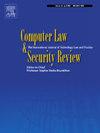通过大型和小型模型的协作增强电荷预测
IF 3.2
3区 社会学
Q1 LAW
引用次数: 0
摘要
电荷预测是人工智能法中的一项基本任务,其目标是根据事实描述预测电荷。尽管已经引入了各种方法来提高性能,但挑战仍然存在。具体来说,基于小模型(SMs)的方法,如BERT,由于其有限的容量,难以处理涉及低频或混淆收费的疑难案件,而基于大型语言模型(LLMs)的方法,如GPT-4,由于缺乏法律知识,在处理各种收费方面表现出困难。为了克服这些限制,我们提出了一个混合框架,结合大型和小型模型来提高电荷预测性能,基于结合每个模型的优势可以克服它们的局限性的想法。最初,SMs提供了一个初始预测以及预测的概率分布。如果最大预测概率低于阈值,llm会介入以反映并根据需要重新预测。此外,我们构建了一个混淆收费词典,并设计了一个两阶段的法律推理提示,这有助于法学硕士对困难案例进行二次预测。在中国和意大利的两个数据集上进行的大量实验证明了该方法的有效性,平均F1分别提高了7.94%和11.46%。此外,细粒度分析表明,我们提出的框架是有效的识别低频和混淆收费。本文章由计算机程序翻译,如有差异,请以英文原文为准。
Enhancing charge prediction through the collaboration of large and small models
Charge prediction is a fundamental task in AI&Law, where the goal is to predict charges based on fact descriptions. Although various methods have been introduced to enhance performance, challenges remain. Specifically, small models (SMs)-based methods such as BERT struggle with hard cases involving low-frequency or confusing charges due to their limited capacity, whereas large language models (LLMs)-based approaches like GPT-4 exhibit difficulties in handling diverse charges owing to insufficient legal knowledge. To overcome these limitations, we propose a hybrid framework that collaborates both large and small models to improve charge prediction performance, based on the idea that combining the strengths of each can overcome their limitations. Initially, SMs provide an initial prediction along with a predicted probability distribution. If the maximum predicted probability falls below a threshold, LLMs step in to reflect and re-predict as needed. Additionally, we construct a confusing charges dictionary and design a two-stage legal inference prompt, which helps LLMs make the secondary prediction for the hard cases. Extensive experiments on two datasets from China and Italy demonstrate the effectiveness of this approach, yielding average F1 improvements of 7.94% and 11.46% respectively. Moreover, a fine-grained analysis demonstrates that our proposed framework is effective in identifying low-frequency and confusing charges.
求助全文
通过发布文献求助,成功后即可免费获取论文全文。
去求助
来源期刊
CiteScore
5.60
自引率
10.30%
发文量
81
审稿时长
67 days
期刊介绍:
CLSR publishes refereed academic and practitioner papers on topics such as Web 2.0, IT security, Identity management, ID cards, RFID, interference with privacy, Internet law, telecoms regulation, online broadcasting, intellectual property, software law, e-commerce, outsourcing, data protection, EU policy, freedom of information, computer security and many other topics. In addition it provides a regular update on European Union developments, national news from more than 20 jurisdictions in both Europe and the Pacific Rim. It is looking for papers within the subject area that display good quality legal analysis and new lines of legal thought or policy development that go beyond mere description of the subject area, however accurate that may be.

 求助内容:
求助内容: 应助结果提醒方式:
应助结果提醒方式:


